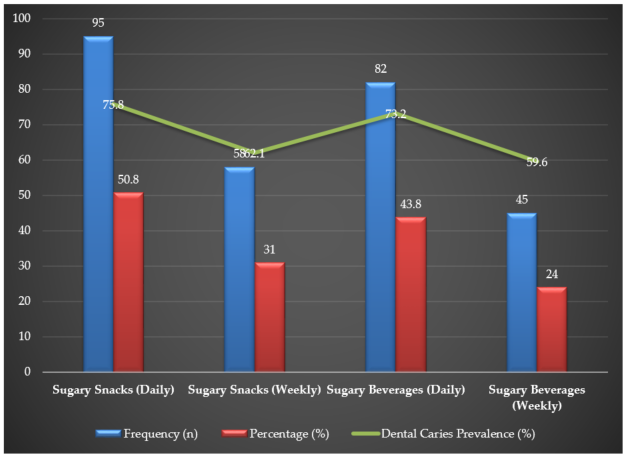Prevalence of Dental Caries and its Association with Dietary Habits in Young Adults
Main Article Content
Abstract
Introduction: A prevalent oral health issue, especially among young adults, is dental caries. The intake of sugary snacks and beverages by young people at Jinnah Medical and Dental College in Karachi was the main focus of this study, which assessed the prevalence of dental caries and its relationship to dietary practices.
Methodology: 187 people between the ages of 18 and 25 participated in a 12-month cross-sectional survey. The DMFT index was used to measure dental caries, and structured questionnaires were used to analyze eating habits. Multivariate logistic regression, one-way ANOVA, Pearson's correlation, and chi-square tests were all used in the statistical study.
Results: The mean DMFT score was 3.42 ± 1.8, and 69% of people had dental caries. Consumption of sugary snacks and DMFT score were significantly positively correlated (r = 0.45, p < 0.001), as was the intake of sugary beverages (r = 0.39, p < 0.001), according to “Pearson's correlation. Significant correlations between frequent sugar consumption” and the occurrence of caries were found by chi-square testing (p < 0.05). The probabilities of dental caries were shown to be enhanced by daily consumption of sugary snacks (OR = 3.12, 95% CI: 1.67–5.86, p = 0.001) and sugary beverages (OR = 2.56, 95% CI: 1.45–4.58, p = 0.002), according to multivariate logistic regression.
Conclusion: Frequent consumption of sugary snacks and beverages is strongly associated with higher dental caries prevalence in young adults. Preventive strategies targeting dietary habits could reduce caries risk and improve oral health outcomes.
Downloads
Article Details
Section

This work is licensed under a Creative Commons Attribution-NonCommercial 4.0 International License.
How to Cite
References
Guo A, Wide U, Arvidsson L, Eiben G, Hakeberg M. Dietary intake and meal patterns among young adults with high caries activity: a cross-sectional study. BMC Oral Health. 2022 May 19;22(1):190.
Akbar P, Salahuddin N, Ahmad Z, Shah SZ, Shah F, Maknoon D. Role of Actinomyces species in oral Biofilm Formation and Dental Plaque-Related Diseases. Innovative Research in Applied, Biological and Chemical Sciences. 2024 Jun 30;2(1):120-5.
Blostein FA, Jansen EC, Jones AD, Marshall TA, Foxman B. Dietary patterns associated with dental caries in adults in the United States. Community dentistry and oral epidemiology. 2020 Apr;48(2):119-29.
Abbass MM, Mahmoud SA, El Moshy S, Rady D, AbuBakr N, Radwan IA, Ahmed A, Abdou A, Al Jawaldeh A. The prevalence of dental caries among Egyptian children and adolescences and its association with age, socioeconomic status, dietary habits and other risk factors. A cross-sectional study. F1000Research. 2019 Jan 3;8:8.
Tenelanda-López D, Valdivia-Moral P, Castro-Sánchez M. Eating habits and their relationship to oral health. Nutrients. 2020 Aug 27;12(9):2619.
Abbass MM, AbuBakr N, Radwan IA, Rady D, El Moshy S, Ramadan M, Ahmed A, Al Jawaldeh A. The potential impact of age, gender, body mass index, socioeconomic status and dietary habits on the prevalence of dental caries among Egyptian adults: a cross-sectional study. F1000Research. 2019 Mar 1;8:243.
Tudoroniu C, Popa M, Iacob SM, Pop AL, Năsui BA. Correlation of caries prevalence, oral health behavior and sweets nutritional habits among 10 to 19-year-old Cluj-Napoca Romanian adolescents. International Journal of Environmental Research and Public Health. 2020 Sep;17(18):6923.
Alshihri AA, Rogers HJ, Alqahtani MA, Aldossary MS. Association between dental caries and obesity in children and young people: a narrative review. International journal of dentistry. 2019;2019(1):9105759.
Paisi M, Kay E, Bennett C, Kaimi I, Witton R, Nelder R, Lapthorne D. Body mass index and dental caries in young people: a systematic review. BMC pediatrics. 2019 Dec;19:1-9.
Bogale B, Engida F, Hanlon C, Prince MJ, Gallagher JE. Dental caries experience and associated factors in adults: a cross-sectional community survey within Ethiopia. BMC public health. 2021 Dec;21:1-2.
Kaye EA, Sohn W, Garcia RI. The healthy eating index and coronal dental caries in US adults: National Health and Nutrition Examination Survey 2011-2014. The Journal of the American Dental Association. 2020 Feb 1;151(2):78-86.
Milona M, Janiszewska-Olszowska J, Szmidt M, Kłoda K, Olszowski T. Oral health related behaviors in relation to DMFT indexes of teenagers in an urban area of North-West Poland—dental caries is still a common problem. International Journal of Environmental Research and Public Health. 2021 Mar;18(5):2333.
Kor M, Pouramir M, Khafri S, Ebadollahi S, Gharekhani S. Association between dental caries, obesity and salivary alpha amylase in adolescent girls of Babol City, Iran-2017. Journal of Dentistry. 2021 Mar;22(1):27.
Koca B, Arkan G. The relationship between adolescents’ nutrition literacy and food habits, and affecting factors. Public Health Nutrition. 2021 Mar;24(4):717-28.
Sun M, Hu X, Li F, Deng J, Shi J, Lin Q. Eating habits and their association with weight status in Chinese school-age children: a cross-sectional study. International journal of environmental research and public health. 2020 May;17(10):3571.
Devenish G, Mukhtar A, Begley A, Spencer AJ, Thomson WM, Ha D, Do L, Scott JA. Early childhood feeding practices and dental caries among Australian preschoolers. The American journal of clinical nutrition. 2020 Apr 1;111(4):821-8.
Nazir MA, Bakhurji E, Gaffar BO, Al-Ansari AS, Al-Khalifa KS. First permanent molar caries and its association with carious lesions in other permanent teeth. J clin diagn res. 2019 Jan 1;13(1):36-9.
Padmanabhan V, Mohammad LT, AlZaabi HK, AwadAlkreem FA. Prevalence of dental caries in children visiting a dental college and Hospital in the United Arab Emirates: a cross-sectional study. The Journal of Contemporary Dental Practice. 2023 Jul 1;24(7):467-72.
